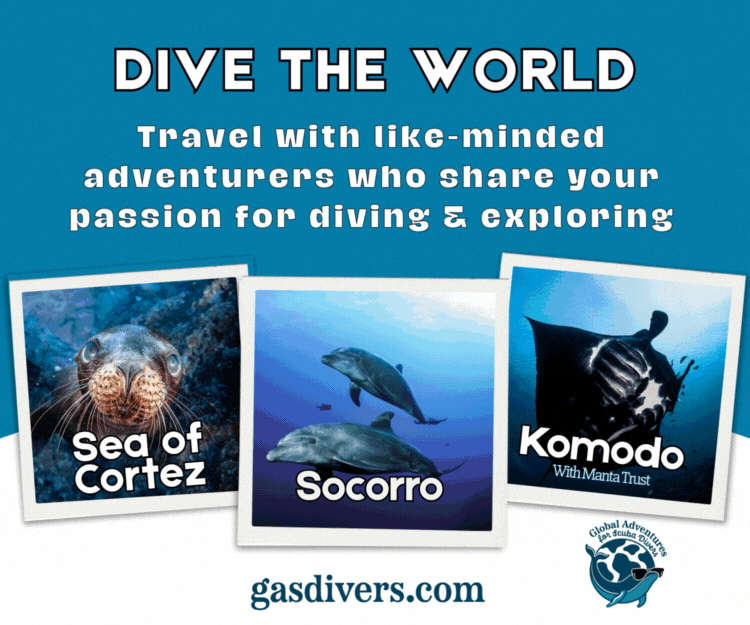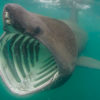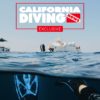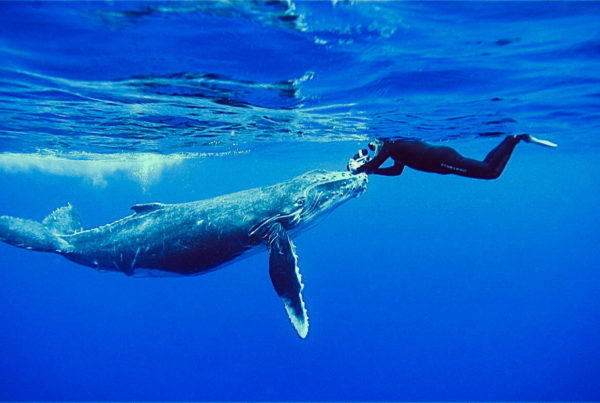 San Carlos Beach has got to be the most versatile dive site in the Monterey area. The dive site located just off the beach, also referred to as The Breakwater, is used for scuba class instructional dives, a great macro photography location, a go-to night dive destination, the location of the “barge” wreck, home to the Metridium Fields, and the location of an almost guaranteed California sea lion (Zalophus californianus) encounter. San Carlos Beach is not just a single dive site but many dive sites rolled into one. This dive spotlight will focus on the dive destination to the sea lion community that exists near the end of the exposed rocky strip called The Breakwater. Fall and winter are the best seasons to visit the sea lions. Interacting with the sea lions involves a fairly long surface swim along The Breakwater wall. There are numbers painted along the wall; the further from the beach the larger the numbers. The sea lion area begins slightly beyond where the numbers stop. Before you descend you should make a dive plan. You have two good options that begin with descending about 25 feet from the wall. Option 1 involves dropping to the sandy bottom where the sand and the wall meet at about a depth of 45 feet and waiting for the playful pinnipeds to come to you. Option 2 consists of dropping to a depth of approximately 20 feet in the kelp and waiting for the sea lions to pass through the kelp. Note that both options involve patience — waiting for the sea lions to approach you.
San Carlos Beach has got to be the most versatile dive site in the Monterey area. The dive site located just off the beach, also referred to as The Breakwater, is used for scuba class instructional dives, a great macro photography location, a go-to night dive destination, the location of the “barge” wreck, home to the Metridium Fields, and the location of an almost guaranteed California sea lion (Zalophus californianus) encounter. San Carlos Beach is not just a single dive site but many dive sites rolled into one. This dive spotlight will focus on the dive destination to the sea lion community that exists near the end of the exposed rocky strip called The Breakwater. Fall and winter are the best seasons to visit the sea lions. Interacting with the sea lions involves a fairly long surface swim along The Breakwater wall. There are numbers painted along the wall; the further from the beach the larger the numbers. The sea lion area begins slightly beyond where the numbers stop. Before you descend you should make a dive plan. You have two good options that begin with descending about 25 feet from the wall. Option 1 involves dropping to the sandy bottom where the sand and the wall meet at about a depth of 45 feet and waiting for the playful pinnipeds to come to you. Option 2 consists of dropping to a depth of approximately 20 feet in the kelp and waiting for the sea lions to pass through the kelp. Note that both options involve patience — waiting for the sea lions to approach you.
If you are unsure about the rules, regulations, and guidelines associated with viewing and interacting with marine mammals NOAA has produced a useful publication titled Responsibly Watching California’s Marine Wildlife. Both interaction options work best on a sunny day. San Carlos Beach is a great place to do a night dive but a night dive with the sea lions is not the best alternative. If you have chosen option 1 you can expect to see what looks like an underwater ballet in which sea lions perform rolls, flips and spins individually or in large groups of 40 or more. An underwater video camera comes in handy to catch all the action. All you have to do is rest on or near the sandy bottom and take in the show.
Along the California coast beginning in 2013 the kelp density began to drop as the purple urchin density began to rise. The kelp canopy has been devastated at many of the central and northern California dive sites. The kelp population has diminished at San Carlos Beach but fortunately the decline has not been as bad as the other sites. If you have chosen option 2 you will likely spot sea lions as they weave through the kelp as sunlight streams down from the surface. This can be a magical experience. One thing to mention about diving with sea lions is that they are pranksters. A common prank they play is sneaking up behind you and tugging on your fins and then zipping away. It can be an unnerving experience to have a large marine mammal act in this manner. Keep the possibility of getting pranked in the back of your mind as you float among the kelp taking in the beauty around you. As you are watching for sea lions in the kelp you may see schools of blacksmith, jellyfish, schools of rockfish, and the occasional harbor seal. The best tool for recording your kelp forest sea lion encounter is an underwater digital camera with a wide angle lens. Pay close attention to your buoyancy as you float through the kelp since boat traffic is not uncommon in this area. Also keep an eye out for fishermen on the breakwater wall. If you descend beyond the fishing area you can minimize your exposure to fishing line and hooks. Carry a knife and multipurpose cutting tool you can use to cut your way out of a fishing line snarl.
When you dive at San Carlos Beach you are a diving ambassador; expect to be asked about your experience by the passing tourists. I recently dove with a visitor from Alabama that often dives in the Gulf of Mexico. He and his wife were thrilled to dive with the sea lions in water that was so clear (compared to the Gulf). I also had the recent pleasure of introducing one of my friends to the sea lions for the first time. She was quite nervous about being in the water with dozens of large mammals. We both had an enjoyable and memorable time interacting with the puppies of the sea.
At-A-Glance
Skill Level: Beginner or better.
Location: Cannery Row and Foam Street in Monterey.
Access: A well-maintained set of stairs leads to the beach.
Facilities: Restrooms and showers, restaurants, a dive center and underwater photo center are nearby.
Entry and Exit: A protected entry area is off the sandy beach just north of the breakwater.
Depth Range: 10 to 60 feet
Conditions: Predictably calm.
Visibility: 10 to 30 feet
Photography: Great macro. Good for sea lion photography during fall and winter.
Hunting: The area is within the Edward F. Ricketts State Marine Conservation Area. Only finfish may be taken with hook-and-line; divers may not take anything.
Cautions: Watch for boat traffic. The parking lot fills up early on weekends. Plan on arriving early on weekends.










